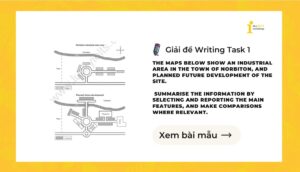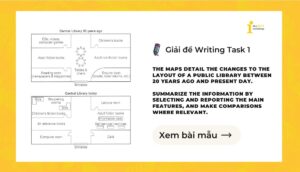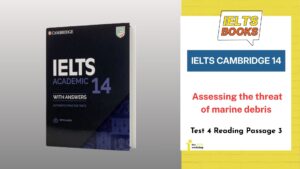Bài viết cung cấp đáp án và hướng dẫn giải chi tiết IELTS Cambridge 14 Test 2 Listening Part 3: Woolly Mammoths on St Paul’s Island bởi đội ngũ giáo viên daỵ kinh nghiệm gỉang dạy của The IELTS Workshop. Hy vọng rằng chúng mình có thể giúp bạn nâng cao kĩ năng làm bài của mình.
Đáp án IELTS Cambridge 14 Test 2 Listening Part 3
| Question | Đáp án |
| 21 | B |
| 22 | C |
| 23 | A |
| 24 | A |
| 25 | E |
| 26 | D |
| 27 | A |
| 28 | H |
| 29 | G |
| 30 | C |
Transcript và bản dịch chi tiết IELTS Cambridge 14 Test 2 Listening Part 3
| Transcipt | Bản dịch |
| TUTOR: So, Rosie and Martin, let’s look at what you’ve got for your presentation on woolly mammoths. ROSIE: OK, we’ve got a short outline here. | TUTOR: Rồi, Rosie và Martin, chúng ta hãy cùng xem các em đã chuẩn bị gì cho bài thuyết trình về voi ma mút lông xoăn. ROSIE: OK, bọn em có một bản dàn ý ngắn ở đây. |
| TUTOR: Thanks. So it’s about a research project in North America? MARTIN: Yes. But we thought we needed something general about woolly mammoths in our introduction, to establish that they were related to our modern elephant, and they lived thousands of years ago in the last ice age. | TUTOR: Cảm ơn. Vậy đây là về một dự án nghiên cứu ở Bắc Mỹ? MARTIN: Đúng rồi. Nhưng bọn em nghĩ cần đưa một số thông tin chung về voi ma mút vào phần mở đầu, để cho thấy chúng có liên quan đến voi hiện đại, và chúng từng sống hàng ngàn năm trước trong thời kỳ băng hà cuối cùng. |
| ROSIE: Maybe we could show a video clip of a cartoon about mammoths. But that’d be a bit childish. Or we could have a diagram, (Q21) it could be a timeline to show when they lived, with illustrations? MARTIN: Or we could just show a drawing of them walking in the ice? No, let’s go with your last suggestion. | ROSIE: Có thể bọn em sẽ chiếu một đoạn phim hoạt hình về voi ma mút. Nhưng có vẻ hơi trẻ con. Hoặc bọn em có thể dùng một sơ đồ, (Q21) có thể là một dòng thời gian để cho thấy chúng đã sống khi nào, kèm theo hình minh họa? MARTIN: Hay là chỉ cần một bức vẽ cảnh chúng đang đi trong băng giá? Không, chọn phương án cuối của bạn đi. |
| TUTOR: Good. Then you’re describing the discovery of the mammoth tooth on St Paul’s Island in Alaska, and why it was significant. ROSIE: Yes. The tooth was found by a man called Russell Graham. He picked it up from under a rock in a cave. He knew it was special – for a start it was in really good condition, as if it had been just extracted from the animal’s jawbone. Anyway, they found it was 6,500 years old. | TUTOR: Tốt. Sau đó là phần các em miêu tả việc phát hiện chiếc răng voi ma mút trên đảo St Paul ở Alaska, và vì sao nó lại quan trọng. ROSIE: Đúng vậy. Chiếc răng được tìm thấy bởi một người tên là Russell Graham. Ông ấy nhặt nó lên từ dưới một tảng đá trong hang. Ông biết nó đặc biệt – trước hết vì nó còn rất nguyên vẹn, như thể mới vừa được nhổ ra khỏi hàm con vật. Dù sao thì, họ xác định được rằng nó đã có 6.500 năm tuổi. |
| TUTOR: So why was that significant? ROSIE: Well (Q22) the mammoth bones previously found on the North American mainland were much less recent than that. So this was really amazing. | TUTOR: Vậy vì sao điều đó quan trọng? ROSIE: Vì (Q22) các mẫu xương voi ma mút trước đó được tìm thấy ở đất liền Bắc Mỹ có niên đại xa hơn rất nhiều. Vậy nên phát hiện này thực sự gây kinh ngạc. |
| MARTIN: Then we’re making an animated diagram to show the geography of the area in prehistoric times. So originally, St Paul’s Island wasn’t an island, it was connected to the mainland, and mammoths and other animals like bears were able to roam around the whole area. ROSIE: Then the climate warmed up and the sea level began to rise, and the island got cut off from the mainland. So (Q23) those mammoths on the island couldn’t escape; they had to stay on the island. | MARTIN: Sau đó bọn em sẽ làm một sơ đồ hoạt hình để mô tả địa lý khu vực vào thời tiền sử. Ban đầu, đảo St Paul không phải là đảo, mà nối liền với đất liền, và các loài như voi ma mút, gấu… có thể tự do đi lại khắp khu vực. ROSIE: Rồi khí hậu ấm lên và mực nước biển bắt đầu dâng cao, khiến đảo bị cô lập khỏi đất liền. Vậy nên (Q23) các con voi ma mút trên đảo không thể thoát được, chúng phải ở lại đảo. |
| MARTIN: And in fact the species survived there for thousands of years after they’d become extinct on the mainland. TUTOR: So why do you think they died out on the mainland? | MARTIN: Và thật ra loài này đã tồn tại thêm hàng ngàn năm nữa ở đảo sau khi chúng đã tuyệt chủng ở đất liền. TUTOR: Vậy các em nghĩ vì sao chúng lại tuyệt chủng ở đất liền? |
| ROSIE: No one’s sure. MARTIN: Anyway, next we’ll explain how Graham and his team identified the date when the mammoths became extinct on the island. They concluded that (Q24) the extinction happened 5,600 years ago, which is a very precise time for a prehistoric extinction. It’s based on samples they took from mud at the bottom of a lake on the island. They analysed it to find out what had fallen in over time – bits of plants, volcanic ash and even DNA from the mammoths themselves. It’s standard procedure, but it took nearly two years to do. | ROSIE: Không ai chắc chắn cả. MARTIN: Dù sao, tiếp theo bọn em sẽ giải thích cách mà Graham và nhóm nghiên cứu xác định thời điểm loài voi ma mút tuyệt chủng trên đảo. Họ kết luận rằng (Q24) sự tuyệt chủng xảy ra cách đây 5.600 năm, là một con số rất chính xác cho một sự kiện tuyệt chủng tiền sử. Kết quả này dựa trên các mẫu bùn được lấy từ đáy hồ trên đảo. Họ phân tích để xác định những gì đã tích tụ theo thời gian – mảnh thực vật, tro núi lửa và thậm chí cả DNA từ chính loài voi ma mút. Đây là quy trình chuẩn, nhưng mất gần hai năm để thực hiện. |
| TUTOR: So why don’t you quickly go through the main sections of your presentation and discuss what action’s needed for each part? MARTIN: OK. So for the introduction, we’re using a visual, so once we’ve prepared that we’re done. | TUTOR: Bây giờ, sao các em không nhanh chóng điểm qua các phần chính trong bài thuyết trình và bàn về việc cần làm cho mỗi phần? MARTIN: OK. Phần giới thiệu thì bọn em dùng hình ảnh, vậy nên chỉ cần chuẩn bị xong là xong phần này. |
| ROSIE: I’m not sure. I think (Q25) we need to write down all the ideas we want to include here, not just rely on memory. How we begin the presentation is so important … MARTIN: You’re right. | ROSIE: Tôi không chắc lắm. Tôi nghĩ (Q25) chúng ta cần viết ra tất cả ý tưởng muốn đưa vào đây, chứ không nên chỉ dựa vào trí nhớ. Phần mở đầu bài thuyết trình rất quan trọng… MARTIN: Bạn nói đúng. |
| ROSIE: The discovery of the mammoth tooth is probably the most dramatic part, but we don’t have that much information, only what we got from the online article. I thought maybe (Q26) we could get in touch with the researcher who led the team and ask him to tell us a bit more. MARTIN: Great idea. What about the section with the initial questions asked by the researchers? We’ve got a lot on that but we need to make it interesting. | ROSIE: Phát hiện về chiếc răng voi ma mút có lẽ là phần kịch tính nhất, nhưng bọn mình không có nhiều thông tin – chỉ có từ một bài báo trực tuyến. Tôi nghĩ (Q26) bọn mình có thể liên hệ trực tiếp với nhà nghiên cứu đứng đầu nhóm để hỏi thêm thông tin. MARTIN: Ý hay đấy. Còn phần các câu hỏi ban đầu của nhóm nghiên cứu thì sao? Bọn mình có khá nhiều thông tin nhưng cần làm cho nó thú vị hơn. |
| ROSIE: We could (Q27) ask the audience to suggest some questions about it and then see how many of them we can answer. I don’t think it would take too long. TUTOR: Yes that would add a bit of variety. | ROSIE: (Q27) Chúng ta có thể mời khán giả đặt một số câu hỏi, rồi xem có bao nhiêu câu trong số đó chúng ta có thể trả lời. Tôi nghĩ sẽ không tốn nhiều thời gian đâu. TUTOR: Ừ, điều đó sẽ tạo sự đa dạng. |
| MARTIN: Then the section on further research carried out on the island – analysing the mud in the lake. I wonder if we’ve actually got too much information here, should we cut some? ROSIE: I don’t think so, but it’s all a bit muddled at present. | MARTIN: Tiếp đến là phần về nghiên cứu tiếp theo trên đảo – phân tích lớp bùn trong hồ. Tôi tự hỏi liệu có phải bọn mình có quá nhiều thông tin không – có nên cắt bớt? ROSIE: Tôi không nghĩ vậy, nhưng hiện tại nội dung hơi lộn xộn. |
| MARTIN: Yes, (Q28) maybe it would be better if it followed a chronological pattern. ROSIE: I think so. The findings and possible explanations section is just about ready, but we need to practice it (Q29) so we’re sure it won’t overrun. | MARTIN: Đúng, (Q28) có lẽ sẽ tốt hơn nếu chúng ta sắp xếp theo trình tự thời gian. ROSIE: Tôi cũng nghĩ thế. Phần phát hiện và các giải thích khả dĩ thì gần như đã xong, nhưng chúng ta cần luyện tập phần này (Q29) để chắc chắn rằng nó không vượt quá thời gian. |
| MARTIN: I think it should be OK, but yes, let’s make sure. TUTOR: In the last section, relevance to the present day, you’ve got some good ideas but this is where you need to move away from the ideas of others and (Q30) give your own viewpoint. | MARTIN: Tôi nghĩ sẽ ổn thôi, nhưng đúng là nên kiểm tra lại. TUTOR: Ở phần cuối, nói về tính liên quan đến thời hiện tại, các em có một số ý hay, nhưng đây là phần mà các em cần tránh lặp lại ý tưởng của người khác và (Q30) đưa ra quan điểm cá nhân. |
| MARTIN: OK, we’ll think about that. Now shall we … | MARTIN: OK, bọn em sẽ suy nghĩ thêm về điều đó. Bây giờ thì chúng ta … |
Phân tích chi tiết IELTS Cambridge 14 Test 2 Listening Part 3
Câu 21 – Đáp án: B
Tiếng Anh: How will Rosie and Martin introduce their presentation?
- A. with a drawing of woolly mammoths in their natural habitat
- B. with a timeline showing when woolly mammoths lived
- C. with a video clip about woolly mammoths
Dịch câu hỏi: Rosie và Martin giới thiệu bài thuyết trình của họ bằng cách: đưa ra một bản vẽ của voi ma mút trong môi trường sống tự nhiên của chúng / một dòng thời gian cho thấy voi ma mút sống khi nào / một video về những con voi ma mút.
Transcript:
- Martin: Okay, so we’ve got our presentation on woolly mammoths. We’ve decided to start with a brief introduction to woolly mammoths, you know, what they were, where they lived.
- Rosie: Yeah, and then we thought we’d use a timeline to show when they lived, and how their existence spanned different geological periods.
Phân tích: Rosie nói rằng họ sẽ “use a timeline to show when they lived”. Điều này trực tiếp khớp với lựa chọn B.
Gợi ý trong bài: use a timeline
Câu 22 – Đáp án: C
Tiếng Anh: What was surprising about the mammoth tooth found by Russell Graham?
- A. It was still embedded in the mammoth’s jawbone.
- B. It was from an unknown species of mammoth.
- C. It was not as old as mammoth remains from elsewhere.
Dịch câu hỏi: Điều gì gây ngạc nhiên về răng của con voi ma mút mà ông Russell Graham đã tìm thấy: Nó vẫn ở trong xương hàm voi ma mút / Đó là từ một loài voi ma mút chưa biết / Nó không lâu đời như voi ma mút từ nơi khác.
Transcript:
- Martin: And then the second section is on the discovery of the mammoth tooth, by Russell Graham. What was surprising about that?
- Rosie: Well, the fact that it was found on St Paul’s Island, and not on one of the larger islands. But also, it was much more recent than any other mammoth remains found anywhere else.
- Martin: Yeah, that was the most surprising thing. That it showed mammoths were still alive much more recently than previously thought.
Phân tích: Rosie nói “But also, it was much more recent than any other mammoth remains found anywhere else.” Martin xác nhận “That it showed mammoths were still alive much more recently than previously thought.” Điều này có nghĩa là nó không lâu đời như những hóa thạch voi ma mút khác, khớp với lựa chọn C.
Gợi ý trong bài: much more recent than any other mammoth remains found anywhere else
Câu 23 – Đáp án: A
Tiếng Anh: The students will use an animated diagram to demonstrate how the mammoths
- A. became isolated on the island.
- B. spread from the island to other areas.
- C. coexisted with other animals on the island.
Dịch câu hỏi: Học sinh sẽ sử dụng biểu đồ hoạt hình để mô tả cách những con voi ma mút: bị cô lập trên đảo / llan rộng từ đảo này đến các nơi khác / cùng tồn tại với các loài vật khác trên đảo.
Transcript:
- Rosie: Then the next section is about how the mammoths got to the island.
- Martin: Yeah, and we’ll use that animated diagram to show how the sea levels rose, and the land bridge disappeared, and they became isolated.
- Rosie: Perfect.
Phân tích: Martin nói “we’ll use that animated diagram to show how the sea levels rose, and the land bridge disappeared, and they became isolated.” Điều này khớp trực tiếp với lựa chọn A.
Gợi ý trong bài: became isolated
Câu 24 – Đáp án: A
Tiếng Anh: According to Martin, what is unusual about the date of the mammoths’ extinction on the island?
- A. how exact it is
- B. how early it is
- C. how it was established
Dịch câu hỏi: Theo như Martin, điều gì không bình thường về ngày tuyệt chủng của những con ma mút trên đảo: độ chính xác của nó / sự sớm sủa của nó / cách nó được thành lập.
Transcript:
- Rosie: And then the fourth section is the actual extinction of the mammoths.
- Martin: Yeah. What’s remarkable about that is the exact date that they’ve managed to pinpoint for their extinction – about 5,600 years ago.
- Rosie: Yes, it’s really unusual to have such a precise date for an extinction event.
Phân tích: Martin nói “What’s remarkable about that is the exact date that they’ve managed to pinpoint for their extinction”. Rosie cũng đồng ý “it’s really unusual to have such a precise date“. Cả hai đều nhấn mạnh về độ chính xác (exact/precise) của ngày tuyệt chủng, khớp với lựa chọn A.
Gợi ý trong bài: What’s remarkable about that is the exact date…
Câu 25. Introduction – Đáp án: E
Transcript: Rosie: So for the introduction, I think we need to write down all the ideas we have, even if we don’t use them all in the end. Martin: Yeah, good idea, that way we won’t miss anything important.
Phân tích: Rosie nói “I think we need to write down all the ideas we have”, đồng nghĩa với việc ghi chú chi tiết. Điều này khớp với lựa chọn E: make detailed notes.
Gợi ý trong bài: write down all the ideas = make detailed notes
Câu 26. Discovery of the mammoth tooth – Đáp án: D
Transcript:
- Martin: What about the ‘discovery of the mammoth tooth’ section? We don’t have that much information, only what we got from the online article.
- Rosie: I thought maybe we could get in touch with the researcher who found it, Russell Graham, just to get a bit more detail.
- Martin: That’s a good idea!
Phân tích: Rosie đề xuất “maybe we could get in touch with the researcher who found it”. Điều này khớp hoàn toàn với lựa chọn D: contact one of the researchers.
Gợi ý trong bài: get in touch with = contact
Câu 27. Initial questions asked by the researchers – Đáp án: A
Transcript:
- Rosie: And for the ‘initial questions asked by the researchers’, that’s where they started trying to work out why the mammoths died out.
- Martin: Yeah. We could ask the audience to suggest some questions about it, like, what would they have asked? That would make it more interactive.
Phân tích: Martin nói “We could ask the audience to suggest some questions about it… That would make it more interactive.” Điều này khớp với lựa chọn A.
Gợi ý trong bài: make it more interactive
Câu 28. Further research carried out on the island – Đáp án: H
Transcript:
- Rosie: For the ‘further research carried out on the island’ section, there’s quite a lot of information, and it’s a bit scattered.
- Martin: I think it would be better if it followed a chronological pattern, to help people understand it. So, we need to organise the content more clearly.
Phân tích: Martin nói “I think it would be better if it followed a chronological pattern… So, we need to organise the content more clearly.” Điều này khớp với lựa chọn H.
Gợi ý trong bài: organise the content more clearly
Câu 29. Findings and possible explanations – Đáp án: G
Transcript:
- Rosie: And for the ‘findings and possible explanations’, that’s probably the most interesting part.
- Martin: Yes, but we need to make sure we don’t go over time there. It’s got a lot of complex scientific explanations. We need to practice it so we’re sure it won’t overrun. So, we should definitely check the timing for that.
Phân tích: Martin nói “We need to practice it so we’re sure it won’t overrun. So, we should definitely check the timing for that.” Điều này khớp với lựa chọn G.
Gợi ý trong bài: overrun, check the timing
Câu 30. Relevance to the present day – Đáp án: C
Transcript:
- Rosie: In the last section, ‘relevance to the present day’, you’ve got some good ideas but this is where you need to move away from the ideas of others and give your own viewpoint.
- Martin: Oh, okay. So, add personal opinions then.
Phân tích: Rosie hướng dẫn Martin “move away from the ideas of others and give your own viewpoint.” Martin xác nhận lại “So, add personal opinions then.” Điều này khớp với lựa chọn C.
Gợi ý trong bài: give your own viewpoint, personal opinions
Series giải đề IELTS Cambridge 14
- [PDF+Audio] Sách IELTS Cambridge 14 (bản đẹp)
- Giải chi tiết Cambridge 14 Test 2 Listening Part 1: Crime Report Form
- Giải chi tiết Cambridge 14 Test 2 Listening Part 2: Visit to Branley Castle
- Giải chi tiết Cambridge 14 Test 2 Listening Part 4: The history of weather
- Giải chi tiết Cambridge 14 Test 2 Reading Passage 1: Alexander Henderson (1831-1913)
- Giải chi tiết Cambridge 14 Test 2 Reading Passage 2:Back to the future of skyscraper design
- Giải chi tiết Cambridge 14 Test 2 Reading Passage 3: Why companies should welcome disorder
Nếu bạn đang tìm kiếm một lộ trình học bài bản, phương pháp rõ ràng và sự đồng hành từ những giảng viên giàu kinh nghiệm, The IELTS Workshop chính là nơi bạn có thể tin tưởng.
Khám phá khóa học IELTS miễn phí tại Website The IELTS Workshop để được trải nghiệm phương pháp học hiện đại, lộ trình cá nhân hóa cùng đội ngũ giảng viên chuyên môn cao ngay nhé!



![[PDF + Audio] Trọn bộ Cambridge Practice Tests For IELTS 1 – 20 mới nhất](https://onthiielts.com.vn/wp-content/uploads/2020/04/cam-1-14-764x400.jpg)
![[PDF + Audio] Cambridge IELTS 20: Cập nhật mới nhất (Bản đẹp)](https://onthiielts.com.vn/wp-content/uploads/2025/07/Cambridge-IELTS-20-300x169.jpg)




